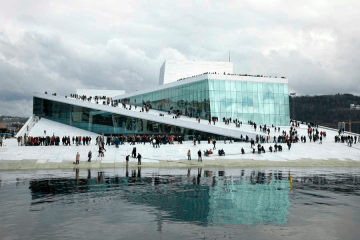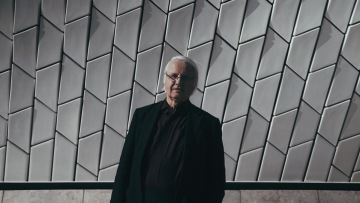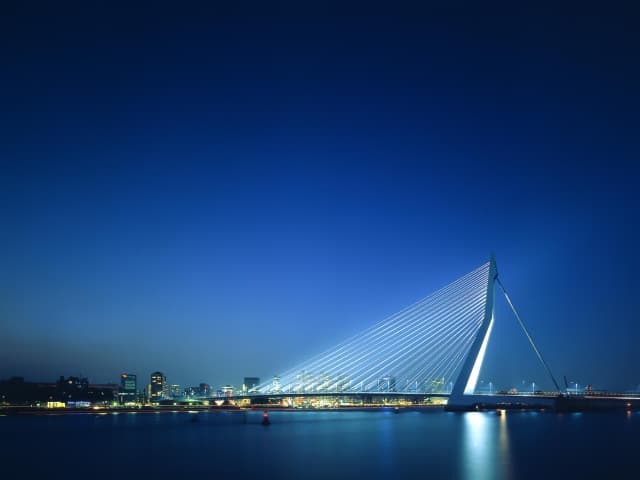
Four Talks on Sound: the Fourth Dimension of Architecture
We interviewed architects, artists, and sound engineers on their practices as they relate and consider this often overlooked dimension of architecture for a special film series, RESONATE Talking Sound + Space from the reSITE RESONATE Thinking Sound + Space Conference which took place at Lisbon's MAAT Museum.
We mostly tend to see and speak about architecture in three dimensional terms, focusing on its visual, spatial and functional aspects. But architecture is always experienced in 4D. Sound and acoustic largely play into people’s experience of public space. Image courtesy of Snøhetta.
RESONATE Talking Sound and Space
Hear from Diller Scofidio + Renfro co-founder, Elizabeth Diller, Snøhetta's Kjetil Trædal Thorsen, pioneer of sound art Bernhard Leitner, and Michael Jones of Foster + Partners plus founders of Meyer Sound, John and Helen Meyer.
1. Elizabeth Diller: Sound is Always There
As architects you really want to be the driver of content.
Elizabeth Diller, founding partner of Diller Scofidio + Renfro, elucidates the importance of sound in architecture and the evolving role of architects must taken on in an increasingly specialization, yet, multidisciplinary world. She also discusses driving purposes and content for effective collaboration and the inside-out means DS+R has approached designing sonically-aware spaces with the 4th dimension of architecture in mind.
2. Kjetil Trædal Thorsen: The Art of Prepositions
Architecture in many ways is the art of prepositions.
Kjetil Trædal Thorsen, founding partner and architect at Snøhetta, talks about connecting with sound and space through ones senses. He emphasizes his method of collaboration called “transpositioning” as a means of engaging across disciplines and keeping architecture truly collaborative. He believes through collaboration we have the opportunity evolve, while that reminding us that everything is connected and trying to solve problems in isolation from one another we miss an important opportunity. "You cannot solve anything on your own."
3. Foster + Partners with Meyer Sound: Sound as Invisible Architecture
An architects job is about dealing with people's senses.
Michael Jones, senior partner at London-based Foster + Partners, on designing spaces, such as the Bloomberg building, that encourage conversation and connection while considering the accoustics of that environment. He is joined by Meyer Sound founders, John and Helen Meyer, as they explain the “invisible architecture” of their Constellation Acoustic System that allow creatives the technology to design sound envionments and change to meet their needs. Finally, senior engineer/project director at Meyer Sound, John Pellowe, talks on the manipulation used to build these stunning sound environments.
4. Bernhard Leitner: Pioneering Sound Art
Sound is a building material.
Austrian-born architect and sound artist, Bernhard Leitner discusses his pioneer work in exploring accoustic spaces as an artist. He is interested in creating spaces with sound, and using it as a building material, and by using "the vocabulary of sound,” Leitner discusses how he uses sound to define space and create completely new worlds.
RESONATE Thinking Sound + Space which took place February 12th, 2018 at the MAAT Museum in Lisbon, Portugal. Videos for the RESONATE Talking Sound and Space series produced by reSITE and Canal 180.
Written by Alexandra Siebenthal
In case you missed it...
Four Talks on the Fourth Dimension of Architecture: Foster + Partners with Meyer Sound
Sound as invisible architecture with Michael Jones of Foster + Partners with John & Helen Meyer of Meyer Sound
Four Talks on the Fourth Dimension of Architecture: Kjetil Trædal Thorsen
The Art of Prepositions with Snohetta architect, Kjetil Trædal Thorsen.
Four Talks on the Fourth Dimension of Architecture: Bernhard Leitner
Four takes on the fourth, invisible dimension that changes the way we experience architecture, with Bernhard Leitner.
Related Stories
Five Talks On Using Design for Social Impact
Socially conscious designers leverage economic, environmental, political and cultural factors and consider them in their efforts to improve the livability of the built environment.
Six Talks on Designing Cities to Include Greenspace
Cities benefit tremendously from the incorporation of greenspace, a connection to nature that is an arena to cultivate community.
Four Talks on Smart Cities: Do They Enhance or Weaponize our Environment
Technology is embedded in contemporary cities. From surveillance cameras to street lights, architects, scientists, planners, and engineers are finding new ways to streamline urban environments to improve the quality of life. Yet, some worry that increasing reliance on technology could lead to its potential abuse, especially when it comes to personal privacy.
Women Make Cities: Five Talks by Women Who Are Shaping the Urban Environment
Within the fields of architecture and urban planning, women are making their case for creating built environments that serve all genders. To close the gap of gender inequality and make spaces more inclusive and safe for women, the unique perspective provided by these speakers is essential to augmenting our idea of design. To move towards more inclusive cities, women must be at the forefront of change.
Related Talks
My City Your City: Berlin
reSITE Berlin Salon in partnership with Airbnb draws a full house
Jean-Louis Missika on Redefining Urbanism in Paris
Jean-Louis Missika, Deputy Mayor of Paris, participates in a discussion on his projects to reinvent Paris through various initiatives and chagnes. He believes that public space is the future, and is shifting towards increasing and improving this space.
Janette Sadik-Khan on the Value of Our Streets + PlaNYC
Janette Sadik-Khan, former Commissioner of the Department of Transportation of New York City, discusses programs implemented in her time in the department and the positive changes these have made. She especially focused on safety and community opinion in her policies, and presents how they made safety programs appeal to people and how much safer she made the streets for pedestrians, cyclists, and drivers.
Caroline Bos on Building Cities for the Future
Caroline Bos, a Dutch urban planner and co-founder of the architectural design center UN Studio, questions the sustainability of our current cities and how to make them last into the future. She brings up ideas of resilience in cities, working with a circular economy, and managing resources more sustainably and effectively.











